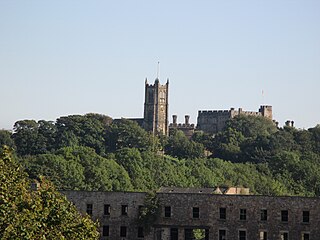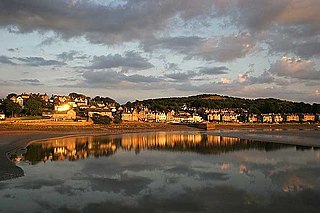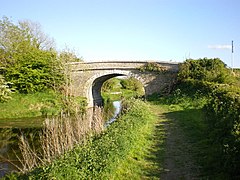
Carnforth is a market town and civil parish in the City of Lancaster in Lancashire, England, situated at the north-east end of Morecambe Bay. The parish of Carnforth had a population of 5,560 in the 2011 census, an increase from the 5,350 recorded in the 2001 census. The town is situated around 7 miles north of Lancaster, 17 miles south of Kendal, 40 miles east of Barrow-in-Furness and 28 miles northwest of Settle. The town is also close to the Cumbria/Lancashire border.

The City of Lancaster, or simply Lancaster, is a local government district with city status in Lancashire, England. It is named after its largest settlement, Lancaster, and also includes the towns of Carnforth, Heysham and Morecambe and a wider rural hinterland. The district has a population of 144,446 (2022), and an area of 219 square miles (567 km2).

Arnside is a village and civil parish in Cumbria, historically part of Westmorland, near the border with Lancashire, England. The Lake District National Park is located a few miles north. Travelling by road, Arnside is 10 miles (16 km) to the south of Kendal, 25.3 miles (40.7 km) to the east of Ulverston, 35.2 miles (56.6 km) to the east of Barrow-in-Furness, 13 miles (21 km) to the north of Lancaster and 14.3 miles (23.0 km) to the east of Grange-over-Sands. In the 2001 census the parish had a population of 2,301, increasing at the 2011 census to 2,334.

Silverdale is a village and civil parish within the City of Lancaster district of Lancashire, England. The village stands on Morecambe Bay, near the border with Cumbria, 4.5 miles (7 km) north west of Carnforth and 8.5 miles (14 km) of Lancaster. The parish had a population of 1,519 recorded in the 2011 census.

Beetham is a village and civil parish in the South Lakeland district, in Cumbria, England, situated on the border with Lancashire, 6 miles (10 km) north of Carnforth. It is part of the Arnside and Silverdale Area of Outstanding Natural Beauty. In the 2001 census the parish had a population of 1,724, increasing at the 2011 census to 1,784.

Yealand Conyers is a village in the civil parish of The Yealands, in the Lancaster district, in the county of Lancashire, England. In 2011 the former parish of Yealand Conyers had a population of 190.

Yealand Storrs is a hamlet in the English county of Lancashire.

Arnside and Silverdale National Landscape in England, is on the border between Lancashire and Cumbria, adjoining Morecambe Bay. One of the smallest National Landscapes, it covers 29 square miles (75 km2) between the Kent Estuary, the River Keer and the A6 road. It was designated in 1972.

Warton is a village, civil parish and electoral ward in the Lancaster district of Lancashire, England. The village is close to the boundary with Cumbria, and approximately 1.5 miles (2.4 km) north of Carnforth, which was originally part of the parish of Warton. The village had a population of 2,315 at the 2001 census, and 2,360 at the 2011 census. The parish covers an area in excess of 11,000 acres (45 km2) and is predominantly rural.

Warton Crag is a limestone hill in north west Lancashire, England. It lies to the north west of Warton village, in City of Lancaster district. At 163 metres (535 ft) it is the highest point in the Arnside and Silverdale Area of Outstanding Natural Beauty, and is listed as a "HuMP" or "Hundred Metre Prominence", having a "drop" or "prominence" of 126 metres (413 ft) with its parent being Hutton Roof Crags. Two areas are Local Nature Reserves, called Warton Crag and Warton Crag Quarry. Different sections are owned by Lancashire County Council, the Wildlife Trust for Lancashire, Manchester and North Merseyside, Lancaster City Council and the Royal Society for the Protection of Birds.

Far Arnside is a hamlet in Arnside civil parish in the South Lakeland district, Cumbria, England.

St John the Evangelist's Church is in Church Lane, Yealand Conyers, Lancashire, England. It is an active Anglican parish church in the diocese of Blackburn. The church was built in 1838, extended in 1861 and again in 1882. It is constructed mainly in limestone, and consists of a nave, a north aisle, a chancel and a west tower. Inside is a west gallery and stained glass by Shrigley and Hunt. The church holds services on Sundays and Wednesdays. It is recorded in the National Heritage List for England as a designated Grade II listed building.

Mourholme, Maurholme, Morhull or Merhull was a manor and castle in north Lancashire, England, in the present parish of Warton, north of Carnforth. The castle of "Merhull" was surrendered to King John in 1216 by Gilbert Fitz Reinfred. It is not known whether it was built of timber or of stone.

Hyning Scout Wood is a wood between Yealand Conyers and Warton in Lancashire.
Lancaster Rural District was a rural district in the county of Lancashire, England. It was created in 1894 and abolished in 1974 under the Local Government Act 1972.

The Yealands is a civil parish in City of Lancaster district, Lancashire, England. It includes the villages of Yealand Conyers and Yealand Redmayne and the hamlet of Yealand Storrs. The parish was formed on 1 April 2024 by combining the former parishes of Yealand Conyers and Yealand Redmayne. It has a parish council, the lowest level of local government in England. In 2021 the parishes had a population of 539.

The Monastery of Our Lady of Hyning is a community of Bernardine Cistercians in Warton, Lancaster, England, formerly known as St Bernard's Priory and informally called Hyning Monastery. Its grade II listed house has also been known as The Hyning, Hyning Priory, Hyning Hall and Hyning House. It is in the north of the parish of Warton, east of the road to Yealand Conyers.
The Yealands is a civil parish in Lancaster, Lancashire, England. It was created in 2024 from the parishes of Yealand Conyers and Yealand Redmayne. It contains 43 buildings that are recorded in the National Heritage List for England as designated listed buildings. Of these, three are at Grade II*, the middle grade, and the others are at Grade II, the lowest grade. The civil parish contains the villages of Yealand Conyers and Yealand Redmayne, and is otherwise rural. Most of the listed buildings are houses, farmhouses and farm buildings, many of them on the main streets of the villages. The other listed buildings include a country house, two churches, and a Quaker Meeting House. The Lancaster Canal passes through the parish, and three bridges crossing it are listed, together with a milestone on its towpath.





















